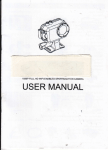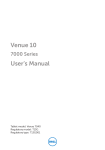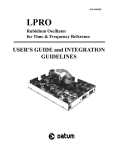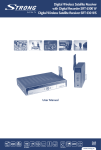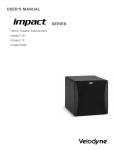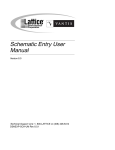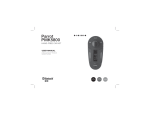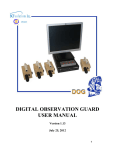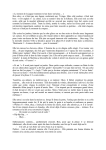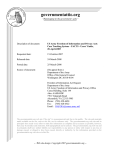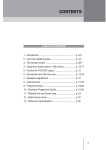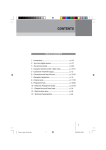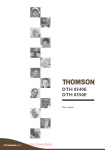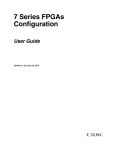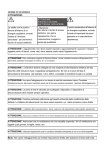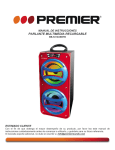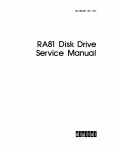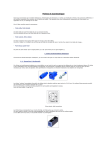Download CD.TV350
Transcript
XSAT DIGITAL/ANALOG RECEIVER CD.TV350 USER’S MANUAL XSAT LE 1ER DÉCODEUR UNIVERSEL 1 Graphics and photos are not contractual. Copies, even partials, are stricktly forbiden. This document can be modified without notice. IMPORTANT WARNING Attention!: these directions for use include specific information, which must not be communicated to people under 18. RECOMMANDATIONS he packaging of your XSAT CD.TV350 includes cardboard and plastic elements, which may be recomposed and recycled for better protection of our environment. We remind you that alkaline batteries must not be thrown into fire. We advise you to keep them or to have them recycled for a better protection of our environment. Storage: Location of your XSAT CD.TV350 receiver: If you do not use this device directly after purchase, you may store it in its original packaging, safe from dampness and water, and at a temperature comprised between -6° C and +50° C. Following this type of storage, it is necessary to let the device reach an ambient temperature before using it. Electrical power supply: This device uses 110-230 Volts Ac power at 5 0/6 0 Hz. Its maximum energy consumption is 40 Watts. The device is delivered with a bifilar A.C. power cord. For your own safety, we advise you not to touch the device outside normal conditions of use (e.g.: dampness). Installation of the satellite dish: Although it is not delivered with the XSAT CD.TV350 receiver, we recommend that you read the installation leaflet of your satellite dish and its fixing. We advise you to consult your antenna technician. Remote control batteries: The remote control of your universal XSAT CD.TV350 receiver is delivered with two alkaline batteries, type RO3G (AAA). Similar type batteries only to replace them. Insert the batteries in the reserved space inside the remote control without forcing and accordingly to the indicated polarities (+ and -). Your universal XSAT CD.TV350 receiver has ventilation slots (on the bottom, on the sides and on the top). These slots must not be obstructed, even partially, in order to ensure proper ventilation of your XSAT CD.TV350 receiver. The lifetime and normal functioning of your device depends on these factors (constant and low internal temperature). This device is designed to operate within a range of normal ambient temperatures: -4°C to +35°C. Installation in premises which are confined or subject to temperature or dampness changes (sheds, attics, cellars, tiny rooms, dry risers,...) may cause an overheating of the device or a premature wear resulting in failures that are not covered by the guarantee. Regarding the location, please leave a 4-centimeter space minimum around and above the device. Avoid putting fabric, paper (magazines), plastic bags, etc... Place your universal receiver in a dry place, safe from dust. It is not designed for outdoor use. Maintenance of your universal receiver: To clean your XSAT CD.TV350 receiver, only use a dry cloth for dust, or slightly dampened with purified water for the front face. Do not use any detergents. Always carry out this operation after disconnecting the receiver from the mains and from the satellite coaxial cable. Warning e draw your attention to the fact that the recording of programs, images, sounds, videograms, broadcasts, software transmitted via earth, satellite or cable, through individual or collective antenna, as well as their rebroadcasting or their commercial use, outside strict family use may result in a violation of the laws for author’s protection. For your own safety: ever open the device. It contains no item repairable by the user. The opening, the modification of circuits or the connection of non-compliant equipment cancels the guarantee. Please return it for maintenance or repair to the point of sale if the device is under guarantee, or to a qualified technician, if no longer under guarantee. In order to reduce the risks of fire, of electrocution or damage caused to another equipment or to people, do not expose the device to dampness, to bad weather, to dust, to sand, to radio electric radiation, to sun, to cold or to high temperature (see the technical specifications page 48 for more details). 2 Remarks concerning electrical devices: his device complies with the European Directive (EN 60.065) and with the ‘electromagnetic compatibility’ Directive (EN 55.013 European standard). This device complies with the European Community Directive on radio electrical disturbances (8 9/336/CE). The manufacturer accepts no responsibility for any use, which does not comply with the recommendations, included in this manual and those made available to the user by mail, by telephone, by telematics, or broadcasted. The manufacturer cannot be held responsible for direct or indirect fraudulent use of the device (example: counterfeiting, piracy, or illicit copy). INTRODUCTION hank you for choosing this digital and analog receiver. By carefully following the instructions of this manual, you will be able to enjoy all the advantages of the digital (DVB standard) and analog (PAL, SECAM) TV and radio reception via satellite. We recommend you to follow the directions and recommendations for use of this receiver very scrupulously, particularly before starting the device. Although it is designed to receive other programs and services, this receiver is pretuned to receive a large number of analog and digital TV and radio programs. This digital receiver complies perfectly with the DVB (Digit al Video Broadcasting) international st andard and includes France Télécom’s Viaccess conditionnal access system. It may also receive other digit al multi-channel packages thanks to the ‘Simulcrypt’ compatibility. It is compatible with television sets and video recorders equipped with a S CART/P E R ITE L connector. Regarding the associated satellite dish our digital XSAT CD.TV350 receiver has been pre-programmed in order to ease starting the device even with a double reception satellite receiver (e.g.: Eutelsat 13°E + Astra). This receiver generates DiSEqCr (Level 1.1) control signals to facilitate the reception of these two satellites. To use it you need a specific configuration of the satellite dish: two universal LNB reception heads (OL: 9.750 and 10.600 Mhz). For the installation of an additional digital or analog receiver (not supplied), an ‘installation kit’ is sold by your reseller. It includes coaxial cable, light set of tools and various connectors. Access restrictions for certain programs: ccess to certain programs is strictly reserved to an adult public (18 years old and above). These programs have to be encoded and require the use of a ‘Confidential Code’ which enables the user to select the desired ‘Moral Level’ regarding the access of each program. This code is not the ‘parental code’ chosen by the user, but a specific access restriction. People less than 18 years old must not access the confidential code, which may be personalized (customized). We draw the attention of adults to specific minors protection laws. People less than 18 years old cannot hold the manufacture responsible for the improper use of this confidential code. SUBSCRIPTIONS: he reception of Pay-TV programs and services is possible with the use of the VIACCESS access card and the corresponding subscription. 3 USER’S MANUAL Table of content 1. PRINCIPLES OF SATELLITE RECEPTION CD.TV350 p. 4 2. YOUR XSAT CD.TV350 UNIVERSAL RECEIVER p. 6 3. CHOOSING YOUR ANTENNA p. 9 4. INSTALLATION OF THE ANTENNA p. 10 5. RECEIVING OTHER SATELLITES p. 12 6. CONTROLLING THE QUALITY OF YOUR INSTALLATION p. 16 7. CONNECTION OF THE RECEIVER AND SWITCHING ON p. 18 8. REMOTE CONTROL AND ADVANCED FUNCTIONS p. 23 9. CONFIGURATION OF THE RECEIVER p. 26 10. ACCESSING A PROGRAM p. 30 11. SECRET CODE AND MORAL LEVEL p. 32 12. PERSONALIZING YOUR RECEIVER p. 33 13. ADDING PROGRAMS p. 35 14. PARENT CODE p. 42 15. VIDEO RECORDING p. 43 16. 16/9 IMAGES AND SURROUND STEREO SOUND p. 44 17. TROUBLESHOOTING p. 45 18. TECHNICAL INFORMATION p. 48 4 1. Principles of satellite reception CD.TV350 The reception equipment: n order to receive the satellite broadcasted programs, the necessary equipment includes a dish connected to a receiver. The receiver is connected to the television set and to other devices such as the hi-fi system or the video recorder. Since 1996, satellite television is using digital technology. It still requires a dish and a receiver, but this equipment is specifically adapted to the new digital technology. The satellite dish: he antenna includes several elements: - Generally of parabolic shape, the satellite dish ➀ includes a ‘reflector’ wich concentrates and send back the waves towards the reception ‘head’ ➁. The ➀ ➁ ➂ ➃ 5 reception “head” receives the satellite frequencies and transforms them into a range of frequencies used by the receiver. When the dish diameter is sufficiently large, a second reception head can be added on the same dish antenna. This antenna will then be able to pick up several satellites (example: Eutelsat 13°E + Astra). The antenna is connected to the receiver via a “coaxial” cable ➂ similar to a TV antenna cable, but much more efficient. The receiver picks up the frequencies conveyed by the antenna and transform them into images (video), sound (audio) and various information (data). It must be connected to a television set and eventually a hi-fi system or a video recorder ➃. The user will control his receiver and ‘zap’ from one channel to the other using the remote control. ➄ ➃ ➄ 6 2. Your XSAT CD.TV350 universal receiver: n addition to programs proposed in a subscription, your XSAT CD.TV350 receiver picks up in clear the TV and radio programs broadcasted by satellite under the DVB (Digital Video Broadcasting) standard and in analog mode (PAL, SECAM). It includes the VIACCESS conditionnal access system designed by France Telecom. The XSAT CD.TV350 receiver can access the programs of digital multi-channel packages using this access control (ABSAT, TPS, ART subscriptions,...) or providing a specific complementary subscription using the Simulcrypt compatibility (digital Canalsatellite, digital Canal+...). The CD.TV350 receiver includes several elements: Its remote control A card reader Connectors Front panel LED’S The remote control: sed to control the usual functions and carry out the different settings of the receiver... Do not loose it! Should it happen however, or should it be out of use, your receiver has two front panel buttons that allows moving from one channel to the other. The card reader: t can receive a specific smart card (VIACCESS) which provides access to the subscriptions. 7 Connections: hey are used to connect your receiver: –> To the mains (France: 220 volts - 50 Hertz) –> To the satellite dish –> To the television set –> To the video recorder –> To the hi-fi system –> To another satellite receiver Power supply: This device functions with a 110230 Volts alternative current at 50/60 Hz. Its maximum energy consumption is 40 Watts. The device is delivered with a two-conductor power cord. Check with your electrician that your electrical installation complies with the NEC 15.100 standard. 8 The Front panel LED’S: hey are used to indicate if the receiver is correctly supplied with electrical power, to check its correct functioning (see ‘receiver settings’ chapter 9), and display various status. A regular updating: our satellite receiver has a real upgradability potential. Like computers using softwares updated on a regular basis, the technicians who created the digital receiver constantly improve its functions. But unlike a computer, this ‘updating’ can be carried out without your intervention. The antenna will pick up its new reprogrammed ‘motor’ after a few minutes spent watching a program, without disturbing its normal functioning. The program editor will inform you of the good news: “your digital receiver is updated!”. If, after changing channels (zapping), your receiver switches to standby position, do not touch anything, it will automatically switch on again after a few seconds. This service is exclusively proposed to the subscribers by Pay-TV broad casters. It is the guarantee that the device you purchase today will be automatically updated. 9 3. Choosing your antenna or an easy and quick start up, your XSAT CD.TV350 universal receiver is pre-configured to receive most popular channels. Moreover, the XSAT CD.TV350 universal receiver also proposes a large number of other digital and analog TV programs which are broadcasted in clear. Several pre-configurations have been set up for the most frequent installations, including a satellite antenna with at least one “universal reception head”. When purchasing the XSAT CD.TV350 universal receiver, make sure this information is specified by the point of sale or your installer. We strongly recommend that you associate a “double reception” antenna to your digital receiver in order to pick up two different groups of satellites (for example, Hot Bird-Eutelsat 13°E and Astra at 19.2°E). For this double reception, the dish diameter should not be under a size recommended by your installer or your point of sale in order to ensure a correct reception of the digital programs where you stay. The change of satellite occurs automatically, and requires no specific handling. A single coaxial cable is necessary. Soon, LNBs For all these points, your reseller will advise you or recommend a specialist. integrating the DiSEqC “intelligent” system will be proposed. Inform your reseller that the XSAT CD.TV350 receiver uses version 1.1 of DiSEqC in order to choose the compatible equipment. In addition, your “universal head” equipped dish can be connected to a second satellite receiver, to pick up additional programs or watch them on the second television set you have at home (contact a specialist or refer to the television set’s directions for use). Finally, the most demanding amateurs may associate an omnisatellite antenna (motorized, monitored by a positioner) and thus, access over 200 channels in clear picked up on about fifteen satellites. A personalized memory management of the XSAT CD.TV350 receiver channels is then required. (see page 33) 10 4. Installation of the antenna: ven if it is possible to carry out such an installation provided you are a little handy, but especially patient and meticulous, nothing replaces the skill and the equipment of a specialist. Do not hesitate to gather practical advice from your point of sale or from a specialized technician regarding the installation of the antenna. An installation carried out by a professional ensures a correct reception of the programs and guarantees troubleshooting in case of malfunction or failure of the antenna. Nevertheless, should you wish to install the antenna yourself, you can ask for the XSAT instruction manual from your reseller. For DiSEqC compatible LNBs and DiSEqC adaptors, ask your reseller or your antenna technician: the XSAT CD.TV350 receiver uses the Level 1.1 DISEqC standard. 11 DIGITAL + ANALOG RECEPTION FROM A SINGLE SATELLITE POSITION his type of satellite reception is simple, but it limits the number of channels and radios that you can pick up (even without subscription or any complementary subscription). We highly recommend to choose the reception of multiple satellite positions, at least Eutelsat 13°E, and Astra 19.2° E. For DiSEqC compatible LNBs and DiSEqC adaptors, ask your reseller or your antenna technician: the XSAT CD.TV350 receiver uses the Level 1.1 DISEqC standard. 12 5. Receiving other satellites: n addition to the Hot Bird Eutelsat satellite at 13 degrees Est, there are other satellites transmitting digital programs (with or without subscription), and analog programs in clear that you can pick up using the XSAT CD.TV350 receiver. A “double reception” antenna enables a complementary offer, by using a switch or DiSEqC controlled LNBs. Your XSAT CD.TV350 receiver is preprogrammed for digital and analog reception (programs in clear) of Eutelsat 13°Est (ABSAT, TPS, ART, MCM), Astra 19.2°Est (digital Canalsatellite) DOUBLE ANALOG + DIGITAL SATELLITE RECEPTION 13 and Telecom 2B (national French programs broadcasted in clear). We recommend the use of satellite dishes equipped with DiSEqC heads or DiSEqC adaptors. The XSAT CD.TV350 receiver uses the DiSEqC system in its Level 1.1 version. Moreover, some reception equipments can pick up several satellite positions using a moving antenna (motorized). In that case, the XSAT CD.TV350 receiver can be associated to a “positioner”, provided that antenna picks up the satellite frequencies used by digital TV. For all these “multisatellite” installations, we advise you to consult an installer specialized in satellite TV reception. DOUBLE DIGITAL + ANALOG SATELLITE RECEPTION WITH DiSEqC™ LNB ‘S 14 The switch he role of this small unit inserted inbetween the different reception heads of the antenna (or antenna) and the receiver, consists of conveying the signal of one of the satellite positions to the digital receiver. There are different models of switches on the market. The system used by the XSAT CD.TV350 receiver is DiSEqC version 1.1. It uses an intelligent switching signal that will “reach” the unit installed on the reception antenna and give the order to change the reception head. We recommend you to use equipment (LNB, adaptors, switches) compatible with the DiSEqC Level 1.1 integrated in the XSAT CD.TV350 universal receiver. Your receiver can also accomodate 22KHz or Tone Burst type switches. TRIPLE DIGITAL + ANALOG SATELLITE RECEPTION WITH DiSEqC™ 15 Switching systems for double satellite reception: DiSEqC his system designed by the European Eutelsat satellite service provider is integrated to your XSAT CDTV 350 receiver. Level 1.1 allows a very simple way to switch the reception from several satellites. Just specify, in the installation menu, whether if it is a single or multisatellite reception. To each received channel corresponds a reception head (LNB1, LNB2, LNB3...), ™ therefore a determined satellite position. Your universal receiver is preprogrammed for instance for Eutelsat 13°E on head number 1 (LN B1) and Astra 19.2°E on head number 2 (LNB2). This principle is also used for collective satellite reception. A specific XSAT document is available from your reseller or installer. We invite you to contact them for any complex installation. Manual switch he simplest is to use a switch equipped with a selection button. But this device forces you to move from your seat each time you want to change from one satellite position to the other. “ON/OFF” Micro-break n the switch, a circuit is going to detect that the current supplied by the receiver (13 or 18 volts) has been interrupted for a short time. A “relay” will transfer the satellite reception onto the available reception head. The major drawback is that this operation requires a minimum time (a delay of several fractions of seconds). In addition, each time the receiver stops or is in standby, there is a change of reception head, and therefore of satellite offer. Infrared: long with the switch located next to the antenna, there is a second unit installed next to the satellite receiver. Depending on the cases, a remote control can be used to ‘switch-over’ to the other satellite. Some infrared switch models require a long action on any of the remote control keys. Drawback: change from one satellite position to the other is rather slow and tedious. Tone Burst he “Tone Burst” system uses a specific signal generated by a device inserted between the receiver and the switch. Some brands use signals such as 60 Hz, 175 Hz or a specific 22 kHz. Attention!, some units limit satellite reception (to a single satellite frequency band). This type of unit is not recommended because of their incapacity to pick up all the satellite frequencies. HOWEVER, there are “Tone Burst” units using the DiSEqC standard. The CD.TV350 receiver is compatible with this type of “Tone Burst DiSEqC” switch for the selection of two satellite LNBs. 16 6. Controlling the quality of your installation The antenna should be connected to the “LNB IN” of the receiver and the receiver to the television set: ➜ Main Menu ➜ (OK) (QUIT) ➜ ➜ ▼ Digital programs Analog programs Program list modification Parent code activation Receiver installation Smart card Language ▼ Installation Parent code change Satellites and LNB DisEqc Miscellaneous settings Digital signal strength OK RETURN QUIT ➜ ➜ Turn the TV set on as well as your CD.TV350 receiver Use the ‘Menu’ key of your XSAT remote control unit. Use the “▼” key (arrow downward) to reach the line “Installing the receiver”. Press ‘OK’.. You have reached the page regarding the installation of the receiver. - Select ‘Digital signal strength’ and validate by “OK”. You can now control the “Quality of reception”’ of your installation. 17 Attention: This control works only with digital channels. When you remove your device Signal strength from its package, it is usualy preset on a Satellite freq. MHz: 12521 Polarisation : Horizontal Eb/No: 9.71 dB J Carrier : digital channel in clear. Otherwise, first select a digital channel in clear using the “List” key of the remote control. Signal strength: ;;;;;;;;;; J Lock ❙ J RETURN QUIT This screen can be used to assess the quality of your satellite reception installation. It highlights the imperfections of your satellite dish choice (which already exists) or its improper settings. This evaluation Signal strength helps identify the source of reception problems, whether digital or analog. This evaluation is carried out for the frequency picked up by the satellite when selecting the setting menu. In the example shown here, the bouquet L Satellite freq. MHz: 12521 Polarisation : Horizontale Eb/No: 2.71 dB Carrier : L ;;; Lock ❙ ■■ L RETURN QUIT (12521 M Hz, polar.H), the important element is the combination of a sufficient level of carrier (rectangles up to the center of the screen) and a correct digital ‘lockout’ (A SINGLE vertical rectangle at the center of the screen). The Eb/ No value is more precise: it indicates for digital reception, the ‘useful’ signal currently used by the receiver. The value must range from 6 dB minimum to 14 dB maximum. The value most currently observed for a correct reception is close to 9 dB (please note that this value varies according to a great number of parameters among which the weather conditions that play a major role). The above screen shows that the satellite reception installation is faulty or incorrectly adjusted. The three parameters “Carrier”, “Lockout” and Eb/No show a reception malfunction. Usually, except in case of bad weather (thunder storms, violent wind, severe snow fall...), the cause of the fault is in the reception installation (satellite dish, switch, too long coaxial cable, bad connections, etc..It is highly recommended to call upon a professional. ➜ Use “QUIT” to exit the “Main menu’” and return to a normal mode. 18 7. Connection of the receiver and switching on n addition to the television set, the XSAT CD.TV350 universal receiver can be connected to a video recorder for example, a hi-fi system and an other satellite receiver. VIACCESS card reader Electrical supply to connect to the mains. (France : 220 volts 50 Hz AC). General power switch “ON - OFF”. “S-VHS” outlet for an “S-Video” (Y/C) inlet television set or a video recorder of S-VHS or HI-8 type. Peripheral sockets for computer system link (Serial), for future applications. Satellite antenna input to connect to the cable coming from the satellite dish. 19 RCA connector Scart cable, RCA plugs and F connector are the ones to use. F connector RED light : receiver’s electrical power supply indicator. ORANGE light : digital TV signal detected, on the antenna. Satellite antenna output to connect to another satellite receiver (‘passive’ mode). GREEN light : encoded program indicator, selection of an auxiliary source (video recorder, other satellite receiver..), lockout. Up and down program selection buttons Standby button / Switch Scart connection to connect to the television set (if your television set was purchased before 1980, you can use an adaptor). RCA connections to connect to the hi-fi system. If you have a Surround sound hi-fi, the ‘spatial’ sound effects will be restored (if the program is in Surround stereo sound). Remote control activation indicator (infrared). Scart connection (VCR) to connect to a video recorder or another satellite receiver for example. 20 Switching on the receiver: SIMPLE SATELLITE RECEPTION (WITH VIDEO RECORDER) To the satellite disk The satellite coaxial cable is more efficient than the TV antenna cable Switching on The antenna, correctly installed and corresponding to the receiver’s preprogramming (universal head antenna), is connected via a ‘coaxial’ cable to the digital receiver ( it resembles a TV coaxial cable, but is much more efficient). The digital receiver must then be connected to the television set and possibly to the other audio/video devices (see diagrams). You can then connect the digital receiver’s electrical supply cord to the mains. It is essential to read to the ‘installation’ paragraph at the beginning of these directions for use. You must introduce the subscription card (if you have a subscription) before turning the digital receiver on. Introduce it delicately and completely into the slot, the chip (microprocessor) has to be introduced face down and towards the receiver, and not face up. Press the ON-OFF switch at the rear of the device, to the right of the receiver’s front face, and then on the button of the remote control. The RED light should then be ON permanently. If the digital receiver recognizes the satellite signal (digital) sent by the antenna, the ORANGE light lights up and should remain lit. 21 CONNECTING A HiFi SYSTEM To the satellite disk If the receiver detects the digital TV signal correctly, the GREEN light lights up, for a few fractions of seconds before the beginning of a program in clear. If the program is encrypted, the GREEN light remains ON. If you haven’t done it already, switch the TV set on. On some television sets, switching on the digital receiver leads to an automatic changeover of the image and sound to the device that is connected to it (video recorder, game console, satellite receiver...). It is an ‘auxiliary input. For the other television sets, it is necessary to select this auxiliary input manually: using the TV remote control or on the TV control board, choose channel zero “O”, ‘“EXT”, “AUX”, “AV” or still “SAT” (refer to the TV instruction leaflet). The first prememorized program should appear on the screen. You can then select the programs memorized in the favorite program list (‘LIST’ button of the remote control). Should you not receive an image, press the MENU KEY to see if your receiver is properly connected, or press the RED “ON/OFF” KEY to switch the receiver on from stand by. 22 Smart card and subscription: ➜ ▼ Main Menu Digital programs Analog programs Program list modification Parent code activation Receiver installation Smart card Language OK QUIT Smart card Adultness level This screen, accessed via MENU and then SMART CARD, is used to modify some parameters included in the access card. It is possible to modify the card’s “access level” in particular (see relevant paragraph). The same screen is used to modify the Secret Code and to consult the current access rights (subscriptions). Choose INFORMATION and then enter the prememorized Secret Code (32896)+, to check the current subscription rights of your card. ➜ The word “Class” refers to the subscription option. ➜ The validity periods depend on the access right modifications. j Access rights Secret code modification IMPORTANT: OK RETURN QUIT Access rights Card number : 3001234567. Service 1 : ABsat num. Classes 1, 2, 3, 4 (22.9.1999 to 31.10.1999) Service N°2 : Canal+ num. Classes 1, 2 (01.9.1999 au 31.11.1999) OK QUIT If the receiver has not been switched on or if some channels have not been watched for a certain number of weeks, these rights could not be loaded in the smart card. Rights are digital information concerning your subscription, which are transmitted among the digital data of the channels you’ve subscribed for. If the message “Scambled program” appears on the screen, you must leave the receiver on one of the programs you subscribed to. After 20 minutes maximum, you should recover access to all the channels. If not, check the chapter “Troubleshooting”, at the end of these directions for use, and contact the Hot Line of your program editor. 23 8. Remote control and advanced functions The remote control and its functions: Start up / standby of the receiver Temporary sound cut (Mute) Number keypad : direct selection of the channels Increase sound volume Decrease sound volume Select following channel / upward selection Select previous channel / downward selection Move to the left (and other functions using the screen menus) Move to the right (and other functions using the screen menus) Selection of the following or previous screen-pages in the “list” choice (and other functions using the screen menus : alphabetical choice, choice of a program from a bouquet…) 24 Available information (current program or using the screen menus) and program guide Display on the screen of the favourite channels Selection of the receiver’s image or the one of the auxiliary source (video recorder, second receiver..) Validation of a command (e.g.: memorization) Safety padlocking: parent code or confidential code (secrets) Display on the main menu screen (settings) Return to previous selection To leave a screen Memorization or selection of a favorite program Satellite programs or television set selection. Call a two digit channel. Digital freeze-frame. Size: normal image selection (4/3) or large image selection (16/9) Selection of the radio station list, of audio channels and memorization of radios. Special functions (used in a future Electronical Program Guide). 25 The remote control and its functions: Some keys of your XSAT CD.TV350 universal receiver’s remote control give access to settings and configuration menus. Validation of operations and selections. For some settings, you simply need to press directly on the remote control keyboard (keys 0, 1, 2, 3, 4, 5, 6, 7, 8 and 9). (Padlock). Parent code. This optional system is used to forbid access to a specific channel or a favorite program, and compels you to enter a secret code to view the channel. The “Information / Guide” key is used to display the details of the current program: name of the channel, title of the program, type of program, time of beginning and end. The “TV/SAT” key can be used to return to television mode. However, the XSAT CD.TV350 receiver remains in use (possibility to record a satellite program while watching a “terrestrial” program) on the TV set. These keys are used to scroll down the alphabet and the figures. For some screens configuration, in order to name or indicate a television program, a radio station or a “program package” of your choice. To modify certain choices (“YES” / “NO”, T1 / T2,…). To correct the letters of a word or a number in some settings screens. 26 9. Configuration of the receiver Main Menu Digital programs Analog programs Program list modification Parent code activation jReceiver installation Smart card Language nce your satellite dish is correctly installed and connected to your XSAT CD.TV350 receiver, you may personalize some settings. VIDEO STANDARD: OK QUIT ➜ You can choose the color standard (SECAM or PAL) that your television set and/or video recorder is going to use. ◆ Select “Installing the receiver” in the “MENU” screen-page ◆ Select “PAL” or ‘“SECAM” ◆ You must absolutely validate this operation by pressing “OK”. Installation Please note: after this change, the receiver comes back to its normal functioning mode (favorite channel 01 is displayed). Parent code change Satellites and LNB DisEqc jMiscellaneous settings Digital signal strength OK RETURN QUIT ➜ If your TV set and your video recorder accept the PAL standard, we advise you to use this selection to be compatible with most satellite broadcasted channels (except the French national channels in clear SECAM mode from Télécom 2B). Please note that a video tape recorded in PAL mode will be viewed in black and white by a SECAM only video recorder or TV set. TV FORMAT: Miscellaneous settings jPAL/SECAM : PAL LNB power supply: YES ? Screen format: 4/3 OK RETURN QUIT The 4/3rd selection is adapted to a traditionnal TV set and screen. The 16/9 format is adapted to a large screen (be careful, if you do not have an adapted screen, the images will be deformed). Please note: some 4/3 format TV sets, compatible with the 16/9 format, display a black band at the top and at the bottom of the screen when16/9 programs are broadcasted. 27 LNB POWER SUPPLY: ➜ This setting must only be modified in the following cases: connection to a collective satellite antenna, a satellite dish motorized by an external positioner which is going to supply the LNB by itself. Apart from these rare cases, the choice should be “YES”. SATELLITES AND LNB: ➜ Your receiver was preprogrammed for a perfect adaptation to a satellite antenna with at least one “universal head” (or LNB converter block with two Local Oscillators – LO – using 9.750 and 10.600 MHz frequencies). Check this with your antenna point of sale. If it is the case, you do not need to modify this setting. AZIMUTH: ➜ For motorized DiSEqC compatible satellite dishes, this selection is used to find the satellite position to pick up. You must then specify the values in tenths of degrees. Example: 192 for Astra at 19.2°Est or 130 for Eutelsat at 13°Est. This indication is only necessary for some DiSEqC type control units. Installation Parent code change jSatellites and LNB DisEqc Miscellaneous settings Digital signal strength OK RETURN QUIT Satellites and LNB j Eutelsat 13°E Astra 19.2°E Telecom 2B/2D 5°O Eutelsat 10°E Eutelsat 16°E Sat 7 Sat 8 OK QUIT DIRECTION: ➜ Associated with the AZIMUT value, it allows localizing the satellite position. West for Telecom 2B/2D, Est for Eutelsat 13°, and ASTRA 19.2°. It is used by motorized DisEqc controlled dishes. Satellites and LNB j Name: Eutelsat 13°E Azimuth (x10): 130° Direction: East LNB Nb: LNB 1 Universal LNB : yes Low LO freq.: 9750 High LO freq.: 10600 DiSEqC: NO Band select: 22 kHz OK QUIT 28 SOURCE NUMBER: Main Menu Digital programs Analog programs Program list modification Parent code activation jReceiver installation Smart card Language OK QUIT ➜ Useful with a DiSEqC switch. This number determines the order of each LNB used. For instance: Eutelsat 13°E for LNB1, Astra for LNB2, Telecom 2B/2D for LNB3, etc...These numbers correspond to the connections of the switch between the dish and the CD.TV350 receiver. TYPE OF LNB ➜ the most UNIVERSAL. frequent type is LOW LO FREQ. AND HIGH LO FREQ.: DisEqc j Remote: NO Remote Freq.: 1248 Switch 1: tone burst Switch 2: none ➜ these two values appear in the technical leaflet of the LNB(s) used, or are indicated by your installer. For a universal LNB, these two values are 9750 and 10600. BAND SWITCHING: OK QUIT RETURN ➜ this information concerns the signal used to select the satellite frequency range to pick up. It is generally a 22 kHz signal. DiSEqC LNB: ➜ If you are using a DiSEqC LN B, select “YES”. ATTENTION: t is essential for the antenna reception head to be compatible with digital signals. Generally, we advise you to be careful with LNBs dating of before 1996. The directions for use attached to your antenna (or to the other satellite receiver you have in addition to the XSAT CD.TV350 universal receiver) should help you check that point. It is always highly unadvisable to connect or disconnect the satellite antenna coaxial cable when the receiver is connected to the power supply. Should the XSAT CD.TV350 receiver ‘block’, a simple action on the ON/OFF switch at the rear of the device allows it to return to a normal functioning. SWITCHES PARAMETERS: ➜ The following settings concern a multiple satellite reception installation (or several receivers in different rooms of the house, connected to a common satellite dish or a collective satellite antenna or a ULB type network..). To configure these parameters, refer to your installer or to the technical leaflet of the equipment (LNB, switches...) 29 SWITCHES UNITS: ➜ This screen adapts the receiver to an external switch command of DiSEqC type. REMOTE: ➜ This setting concerns only collective satellite antennas equipped with a “remote control” DiSEqC system. For traditionnal DiSEqC switch units, choose ‘“NO”. DisEqc j Remote: NO Remote Freq. : 1248 Switch 1: tone burst Switch 2: none OK QUIT RETURN REMOTE FREQ.: ➜ This setting concerns only collective satellite antennas equipped with a “remote control” DiSEqC system. For traditionnal DiSEqC switch units, do not modify it. CHOOSING THE TYPE OF SWITCH: SWITCH 1: ➜ In this setting, select the DiSEqC type indicated in the technical leaflet of the switch. There are 5 possibilities. Before you modify the settings, ask your installor. SWITCH 2: ➜ If your equipment includes several DiSEqC switch units, select the DiSEqC type corresponding to each installed unit. Consult your installer for more details. - None: for a unit which is not compatible with the DiSEqC system, or a satellite dish with a single LNB. COLLECTIVE SATELLITE ANTENNA : ➜ It is possible to configure your XSAT CD.TV350 receiver so that it adapts to a collective satellite reception. In that case, on the line “remote”, select “yes” instead of “no”. You must then specify the intermediary operating frequency value. Consult the installer or the company in charge of your collective antenna for this type of information. - TONE BURST (or mini-DiSEqC): to switch to the first and the second LNB consecutively using a specific 22 kHz signal. - POSITION pilots a DiSEqC switch unit including at least 4 inputs. - POSITION + OPTION pilots a DiSEqC switch unit including at least 8 inputs. - UNCOMMITTED: for complex collective configurations associating several DiSEqC switch units. Installers can get detailed technical information by the manufacturers or from EUTELSAT). 30 10. Accessing a program ZAPPING AND DIRECT SELECTION OF A TV CHANNEL. Prefered TV programs jABsat TF1 France 2 France 3 Arte/La 5e M6 TV5 Europe CNN OK QUIT RETURN ❤10 ❤ 11 ❤ 12 ❤ 13 ❤ 14 ❤ 15 ❤ 16 ❤ 17 Example of analog channels (in blue) and digital channels (in black) broadcasted in clear without additional subscription required, received on Eutelsat 13°E, Astra and Telecom 2B. A motorized antenna or two fixe satellite dishes needed. mong the hundreds of TV programs your XSAT CD.TV350 receiver can memorize, you can select up to 99 “favorite” TV programs. It will be easier for you to find directly your favorite programs, without long research. There is another way to access a bouquet. After having entered A SINGLE channel in favourite mode as explained (little heart key), you can access all the channels that belong to this package. Use the double arrow keys to move on from one channel to the other. This function provides access to a lot more than simply 99 favourite channels. ACCESS TO ALL CHANNELS ➜ “Digital channels and analog channels” of the main menu provides access to all memorized channels and radios (that are not in the favourite lists). Simply select a digital or analog channel or radio and validate by OK. Programs of ABsat AB1 AB Animaux AB Chasse & Pèche AB Auto/XXL AB Musique Class AB Histoire / Fit AB Nostalgie jAB Tests ❤ 01 ❤ 02 ❤ 03 ❤ 04 ❤ 05 ❤ 06 ❤ 07 ❤00 OK QUIT RETURN YOUR FAVOURITE CHANNELS The LIST key provides access to the favourite TV list. In BLACK, digital channels, and in BLUE, analog channels. REMOVE A CHANNEL FROM A LIST ➜ Select the “Digital bouquet” screen or the “Analog Programs” screen, according to the type of channel, in the MENU. Select the channel in the list of this screen (or in that of the corresponding digital bouquet) Press (❤) (a double hyphen appears in the right hand corner of the screen). Press “00” (zero zero) Or choose a new favourite channel. 31 SELECTION OF ANOTHER TV SOUND OR A RADIO ➜ While watching a digital or analog TV program, you can choose another sound channel to accompany the image or a radio operating on the same TV channel. Some channels like Eurosport International, TNT, The Cartoon Network, Euronews... propose several versions for their programs. This selection is temporary. By zapping again on this channel, the main sound channel (language) is automatically restored. Please note: for analog radios and analog TV audio channels no specific name appears on the screen. Motors TV Sound channel 1 LIST OF FAVOURITE RADIOS ➜ The RADIO key provides access to the list of favourite radio stations. Please note: the name of analog stations is displayed in Blue. The name of digital stations is displayed in Black. The selected station is in Red. To add, remove or change the order of a radio in the favourite list: M ENU ➜ Select the “Digital bouquet” screen or the “Analog Programs” screen, according to the type of channel, in the MENU. Select the channel in the list of this screen (or in that of the corresponding digital bouquet) Press RADIO (a double hyphen appears in the right hand corner of the screen). Press “00” (zero zero) Or choose a new favourite channel. Radios jRadio Nostalgie Radio Classique Klassic Radio France Musique France Culture Eur Hector Sky Radio Virgin Radio ❤01 ❤ 02 ❤ 03 ❤ 04 ❤ 05 ❤ 06 ❤ 07 ❤ 08 OK QUIT RETURN Radios Truc FM R 20 Radio Machin R 21 Bidule International R 22 AB Radio R 23 Station W R 24 Music R 25 Rigolo Radio R 26 jAB Tests radio R 00 OK QUIT RETURN 32 11. Secret Code and Moral Level his secret code can reduce the access to some adult programs (18 years old and more). Each time this “protected” program is selected, the Secret Code will be requested. This mechanism will function according to the “access level” of the broadcasted program. Main Menu Digital programs Analog programs Program list modification Parent code activation Receiver installation jSmart card Language OK QUIT Adultness level change Adultness level j New level (0-15):7 Secret code:***** OK RETURN QUIT ◆ Before starting the XSAT CD.TV350 receiver, introduce the access card, the chip must be face down (and not face up). ◆ Switch the receiver on. ◆ Select the “adult” program. ◆ Enter the Secret Code ◆ A temporary secret code is prememorized (32896). ◆ You can change it and replace it by a code of your own. Enter the current code and then enter your Secret Code in the appropriate screen. ◆ Keep note of your code and do not loose it. The subscription card would have to be changed (at your expense). ◆ To suppress all restrictions, enter a level, which is higher than the level of the concerned program (example: 7) instead of the restrictive level. We attract your attention on the fact that this Secret Code must not be communicated to minors. This Secret Code is under your responsibility. If you wish to forbid access to certain programs during your absence, we advise you to use the Parental Code. (See chapter 14 page 42). 33 12. Personalize your receiver sing screens (menus that are displayed on the TV set), you can personalize a certain number of parameters so as to adapt the current use of the XSAT CD.TV350 receiver to your personal taste. Most settings can be carried out from the main menu, accessible via the ‘MENU’ key. Main Menu Digital programs Analog programs Program list modification Parent code activation jReceiver installation Smart card Language (OK) (QUIT) BOUQUETS digital ‘bouquet’ is a kind of binder in which TV and radio channels are found. Each digital bouquet is characterized by specific settings: satellite frequency (from 10700 to 12750 MHz), polarization (vertical or horizontal), Symbol Rate (flow of information per second) Viterbi Rate (digital compression flow). Please note: it may be necessary to carry out an automatic search from time to time among the digital bouquets in order to update them. Open an existing digital bouquet ➜ Press: MENU (You can interrupt your settings using: QUIT) Each selection is displayed in red. To move on to the next line: (▼) To validate your choice: OK Select ‘Digital bouquets’ + OK Digital bouquets ➜ Select a bouquet using: (▲), (▼) To move on to the next character (in a title) or to create a space, use: > To correct a line: < To come back to the previous line: (▲) (see example: “ABsat 1” Digital bouquets jABsat 1 ABsat 2 Viacom Turner Canalsat 1 Canalsat 2 Canalsat 3 Canalsat 4 -/-OK RETURN QUIT 34 Parameters of the bouquet Bouquet parameters jName: ABsat 1_ Satellite : EUT 13°E Sat. Freq. MHz: 12521 Polarization: Horizontal Symbol rate : 27500 Viterbi rate : 3/4 Program search : yes OK QUIT RETURN Programs of ABSAT ❤ 01 AB Sports ❤ 02 AB Animaux ❤ 03 AB Chasse & Pèche ❤ 04 AB Auto/XXL ❤ 05 AB Musique Classique ❤ 06 AB Escales ❤ 07 AB Histoire/Fit VLV ❤ 08 -/-(OK) (QUIT) (RETURN) jAB1 Example Program settings ➜ Name: you can modify the name of this bouquet. Satellite: > and < select the satellite which is broadcasting this bouquet. Sat. freq. MHz: 0 to 9 Polarization: choice by ( ) or ( ) Symbol rate: 0 to 9 Viterbi rate: choice by ( ) or ( ) Automatic search: by selecting NO with ( ) or ( ) you memorize the parameters manually, without any automatic search (syntonizing). For an automatic search: YES Validate by OK (a few seconds are required) The programs... ➜ the program list appears. In BLACK: TV channels and in B LUE: radios ❤ is used to choose the memorized TV channel, from ❤ 01 to ❤ 99 (a double hyphen appears in the bottom left hand side of the screen). Choosing ❤ 00 will erase the channel from the list. ➜ Radios (in BLUE) can be memorized in the same way in the favourite radio list. The “RADIO” key of the remote control enables you to choose the favourite radio memorization channel (from R01 to R99). Choosing R00 will erase the station from the list. jName : AB1_ Video PID : Audio PID : Synchro PID : (OK) (QUIT) (RETURN) 160 80 160 Create a digital channel ➜ For some specific transmissions or when an automatic search is impossible, it may be necessary to manually create or add a channel in a digital bouquet, choice: Program edition. Some parameters must then be specified: the PID (Video, Audio and Synchronization identifications). Select the channel in “Digital bouquets” and then in the corresponding bouquet. Validate by >. Enter the values required, and validate by OK. 35 13. ADDING PROGRAMS ome technical values (frequency, polarization, PI D, Symbol Rate, Viterbi Rate…) are essential for the correct setting of the memory in digital mode. Program editors, and the satellite TV magazines, can provide you with some information related to this technical data. Editing program list jNew bouquet New digital program New analog program Reset list OK QUIT RETURN AUTOMATIC CREATION OF A “DIGITAL MULTI-CHANNEL BOUQUET” ➜ ➜ ➜ ➜ ➜ MENU PROGRAM LIST MODIFICATION OK NEW BOUQUET OK Specify ➜ The name of this package ( , , , ) ➜ the frequency (5 digits) ------➜ the polarization (Horizontal or vertical) ➜ the symbol rate value (usually 27500) ➜ the Viterbi rate (usually 3/4) ➜ Validate ‘program search’: YES ➜ OK After 3 to 6 seconds, the programs (and radio stations) of this digital multichannel bouquet are automatically memorized. After what, you simply need to select them directly in the “Program List”, or memorize them using the (❤) favourite mode . Bouquet parameters jName Satellite: EUT 13°E Sat. freq. MHz: Polarization: Vertical Symbol rate: 27500 Viterbi rate: 3/4 Program search: YES OK QUIT RETURN Reset program list jEutelsat 13°E Astra 19,2°E Telecom 2B/2D All programs OK QUIT RETURN 36 Editing program list Editing program list New bouquet New digital program New analog program j Reset list ➜ This menu is used to create or modify a channel (radio or TV). It also reset the unit to the initial settings or the updates concerning the pretuned channels (choice “Reset list”). An automatic updating of channels (and radios) is only proposed to people with subscriptions. But it can be done manualy. OK RETURN QUIT Reset list ➜ According to the type of satellite dish and to the satellites received, it is possible to choose a specific memorization mode (add channels and radios to the already proposed list). This operation is instantaneous. jEUTELSAT 13°E ASTRA 19,2°E TELECOM 2B/2D 5°O EUTELSAT 16°E EUTELSAT 10°E All programs Be careful: any previous personalization (favourite list or manual adding of a channel) is replaced by this selection. You can always personalize the settings again, from this reset operation. OK RETURN QUIT Selecting a reset list ATTENTION: this reset operation modifies the personalized and favourite syntonizing operations (adding channels and radios, changing the order of the channels, modifying preferences...). You can always carry out new personalized settings after this operation. ➜ Each configuration of the “Reset list” depends on your choice of programs and on the satellite dish used. You can automatically and instantaneously pretune to the digital packages and the analog channel groups proposed by one or several satellites. ➜ This reset affects the favourite list previously defined. A new favourite list is created in replacement. You can always modify it (see previous paragraph). ➜ The CD.TV350 receiver is preconfigured for a dish oriented towards Eutelsat at 13°Est and a selection of analog and digital channels broadcasted on the same satellite position. 37 REMOVING A PROGRAM OR A DIGITAL BOUQUET ➜ These operations allow suppression of the programs you do not wish to keep in the lists. This operation is useful when the message “Memory overload” appears. You can therefore select the encoded TV and radio channels you wish to suppress. Removing a digital bouquet ➜ In the “Digital bouquet” list, that can be accessed via the main menu, select the digital bouquet you wish to suppress, and validate by using <. When the suppression screen appears, validate your choice by OK or cancel this operation by “QUIT” or “RETURN”. Removing a digital program (TV or radio) ➜ In the “Digital bouquets” list, that can be accessed via the main menu, select the digital bouquet that contains the program you wish to suppress, validate by OK. In the channel or radio list of this bouquet, select the program you wish to suppress. Validate using <. When the suppression screen appears, validate your choice by OK or cancel this operation by ‘QUIT’ or ‘RETURN’. Removing an analog program ➜ In the “ANALOG PROGRAMS” list, that can be accessed via the main menu, select the TV channel or radio you wish to suppress. Validate using <. When the suppression screen appears, validate your choice by OK or cancel this operation by “QUIT” or “RETURN”. Programs of ABSAT AB 1 AB Sports AB Animals AB Hunting & Fishing AB Automobile / XXL AB Classical Music AB Stopovers AB Stories / VLV FIT -/-(OK) ❤ 01 ❤ 02 ❤ 03 ❤ 04 ❤ 05 ❤ 06 ❤ 07 ❤ 08 (QUIT) (RETURN) Delete bouquet ...........CAUTION........... Press (OK) to delete the ABSAT bouquet and its programs Press (QUIT) to cancel (OK) (QUIT) (RETURN) Delete program ...........CAUTION........... Press (OK) to delete program XYZ Press (QUIT) to cancel (OK) (QUIT) (RETURN) 38 CREATING AND MEMORIZING AN ANALOG CHANNEL Remark: Some technical values (frequency, polarization, PID, Symbol Rate, Viterbi Rate…) are essential for the correct setting of the memory. Program editors, like ABsat, can provide you with some information related to this technical data. Program parameters Analog program jProgram type: TV Name: TV5 Satellite: EUTELSAT 13°E Frequency MHz: 11322 Polarization: Vertical Stereo: NO Audio freq. kHz: 6600 Bandwidth: 380 Deemphasis: J17 Video gain: +2dB OK QUIT RETURN EXAMPLE OF A MONO-SOUND CHANNEL Analog program jProgram type: TV Name: VIVA Satellite: EUTELSAT 13°E Frequency MHz: 11006 Polarization: Horizontal Stereo: YES Audio freq. kHz: 7020 Bandwidth: 110 Deemphasis: P Video gain: +2dB OK QUIT RETURN Choice of the program type: TV or RADIO Name: To modify or create the name of a channel. ● Satellite: > and < select the satellite which is broadcasting this package. Please note: in the “satellites” setting page, it is possible to create or modify the parameters related to a satellite configuration (they must be adapted to the dish used). ● Sat. freq. MHz: 0 to 9 Remark: it may be necessary to adjust this setting (+ or - 1 MHz). ● Polarization: horizontal or vertical ● Stereo: if the associated TV sound is in stereo, choose YES ● Audio freq. MHz: this choice corresponds to the ‘subcarrier’ frequency dedicated to the sound channels associated to the TV image. In stereo, the values go by pairs (e.g.: 7.02/7.02 kHz). ● Bandwidth kHz: it is sometimes necessary to adjust the sound setting: “Bandwidth” (110 narrow, 180 normal or 380 large). ● Deemphasis: Stereo usually corresponds to the “P” mode, whereas mono uses rather: 50, and sometimes J17. ● Validate by OK (immediate memorization). ● ● Analog video gain: EXAMPLE OF A STEREO SOUND CHANNEL ➜ Improves the image of an analog channel received by satellite. But does not work if the reception is poor. 39 CREATING AND MEMORIZING AN ANALOG RADIO Creating an analog radio ➜ In the choice “program type”, you can create a radio station on the same principle as an analog TV channel. You can add it in your favourite “Radio” list (that can be accessed via the RADIO key). In order to classify each station in the Radio list, select the list in MENU, and then in ANALOG PROGRAMS. Use the RADIO key and then 01 to 99 to classify it. To erase a radio station from the list, instead of a number from 01 to 99, press 00 (zero, zero). It will disappear from the RADIO list (but not in the syntonizing). Radios in the TV list ➜ The favourite TV lists (“List’ key”) and favourite Radios (“RADIO” key) can be combined for radio stations. If the 99 stations are used up in the radio list, you can proceed as if it were a favourite TV channel. Remark: but, you cannot classify a TV channel in a favourite Radio list, as its image won’t appear (only the sound will be accessible in the Radio list). Display of the name of a station ➜ By selecting a radio station in the “Radio” list, its name will appear on the screen. Remark: if your CD.TV350 receiver is connected to a hi-fi system or an amplifier, there is no need for you to leave the TV on. Should there be disturbances or noise in the sound of a radio station, start by referring to the paragraph “Troubleshooting” (page 45). Analog program jProgram type: Radio Name: Radio Melodie Satellite: EUTELSAT 13°E Frequency MHz: 11055 Polarization: Horizontal Stereo: YES Audio freq. kHz: 7740 Bandwidth: 110 Deemphasis: P Video gain: 0dB OK QUIT RETURN EXAMPLE OF A STEREO SOUND RADIO Radios jRadio Bingo Tutut FM Machin 98.5 Classica Music Info News Radio FM Total Station Jazz -/-OK QUIT RETURN Radio program: Radio 1 - Melodie MENU RADIO R01 R 02 R 03 R 04 R 05 R 06 R 07 R 08 40 AUTOMATIC UPDATING Update receiver jPlease wait a few seconds... Your device will turn OFF, and ON again automatically If this screen appears, do not touch anything when your receiver turns off automatically. To check the software version used by your receiver, press MENU and then ‘i/GUIDE’. ➜ The functionnalities of your CD.TV350 receiver can be improved (menus, functions, settings…). This operation can be performed automatically. Simply select one of the Pay-TV programs (for instance the ABsat channel) and stay there for about twenty minutes. Then, a simple validation is necessary (usually a simple zapping using the upwards arrow of the remote control). ➜ A message informs you of the actual update (“Receiver updated”). The CD.TV350 receiver switches off automatically during a few seconds before switching on again. Do not touch anything during this operation. The receiver is updated. To check the new software version, use MENU and then “i/GUIDE” on the remote control. ➜ The new version is displayed on the top of the screen and remains there for a few seconds. INFORMATION ON THE CURRENT PROGRAM 11- AB thriller Association de malfaiteurs Thriller Start: 7.05 pm End: 8.45 pm Next program: (OK) Later on: AB Thriller On les aura Thriller Start: 8.46 pm End: 10.05 pm (OK) Remark: this service will be operational progressively. It is not available on all the digital channels received by the CD.TV350 receiver. It does not replace the Electronic Program Guide available with television sets using the Teletext function. ➜ While watching one of channels, you can access several informations related to the program you are watching. ➜ The title of the program, the type of program, the beginning and end, using “i/GUIDE”. To get some information concerning the following program, press OK. To return to the program you are watching, press OK again, “i/Guide” or QUIT. 41 DIGITAL ‘FREEZE’ FUNCTION ➜ While watching a digital channel, the FREEZE key stops the movement of the image. It is not a pause, since the program proceeds normally. This function can be practical for those who wish to break down the movement, take note of an important piece of information on the screen, or control the detail in the image. This function is also used to start a video recording with style. The FREEZE key does not function with analog TV channels. Freeze function on: AB Sports Resume program: OK PROGRAM GUIDE BY TELETEXT ➜ If your TV set has the Teletext function (e.g.: CEEFAX), it will give you information about: ➜ Daily information, news headlines, weather report, stock market...Many topics are covered on the French and foreign channels. The Electronic Program Guide is proposed on some TV channels. It provides instantaneously, details on TV programs by type of program, channel and schedule. ➜ You can also search for all the Films programmed at 8 PM today. ➜ A summary of some programs will also guide you, to help you choose your programs. Therefore an answer to all your questions from “What’s on TV tonight?’”, to “what do I want to watch on TV tonight?”. Remark: this service is not available on all channels. Télé texte SEARCH By TYPE By SCHEDULE By CHANNEL Choice + OK Choice : + (OK) Télé texte Search: Movie tonight 20.00 Les Aventuriers (Action) 20.10 Le Colporteur (Comédie) 20.10 Music Hall (Musical) 20.12 Lucky Louis (Western) 20.22 Le Crime (Policier) 21.30 Passion perdue (Drame) 23.05 Erotismes (Adulte) 00.05 Luxure X (Adulte) The Movie, tonight Choice + (OK) P601 P602 P603 P604 P605 P606 P607 P608 P610 42 14. Parent code his system restricts the XSAT CD.TV350 receiver functionalities (settings menus) and program access to the users who know the “Parent Code”. In their absence, adults who wish to limit the access of the receiver to children, must use this code. This code is not the “Confidential Code” (see “moral level”, page 32) used to access certain adult programs. TO ACTIVATE THE PARENT CODE Parent code activation jCode active: YES OK RETURN QUIT ➜ In the “Menu”, select “PARENT CODE ACTIVATION “. ➜ Validate by “OK” ➜ To modify “Code active = NO”, use keys or . ➜ Validate by ‘OK’. As from now, the access is restricted. In the “Menu”, no modification (except “QUIT”) can be carried out as long as the correct code is not entered (4 figures at the bottom left hand side of the screen-page). The code preset in factory is: 1234. We advise you to choose a code of your own. TO LIMIT ACCESS TO CERTAIN CHANNELS ABsat1 programs AB 1 ❤ 01 AB Sports ❤ 02 AB Animals ❤ 03 AB Hunting & Fishing ❤ 04 AB Automobile / XXL ❤ 05 AB Classical Music ❤ 06 AB Stopovers ❤ 07 AB Stories / VLV FIT ❤ 08 -/-(OK) (RETURN) (QUIT) ➜ In the “Menu”, select “PROGRAM LIST” ➜ Validate by “OK” ➜ Select the ‘bouquet’ and then the digital program to “protect”. ➜ Using the ( ) key, add the padlock symbol next to the program you want to restrict access to. The program is restricted and requires a 4-figure code to be watched. Proceed in the same way for all or part of the programs in the memory. TO MODIFY THE PARENT CODE ➜ In the “Menu”, select “Receiver installation” then “Parent code modification”. ➜ Validate by “OK” ➜ Enter the old Parent Code. ➜ Choose and enter your new Parent Code. ➜ Validate by “OK” Please note: should you loose or forget your Parent Code, contact the Hot Line. 43 15. Video recording our XSAT CD.TV350 universal receiver can be connected to a video recorder (with at least one scart connector). The XSAT CD.TV350 remote control key “AUX” (below number zero) will be necessary during the normal use of the video recorder (playing from the recorder). ◆ Your video recorder must include an auxiliary audio/video input. Select this auxiliary input on your video recorder. It usually is the “O” (zero), “EXT”, “AUX’, ‘AV” or even “SAT” channel (refer to the video recorder instruction leaflet). If your video recorder includes no scart connector (manufactured before 1988), or if this connector is not compatible, you can use a cord or an adapter to connect the digital receiver to the video recorder. ◆ Select the program you wish to record (which should appear on the screen). ◆ Your video recorder can now record the program’s image and sound (possibly in stereo). Be careful: your receiver and video recorder must use the same TV standard. Check that they are both configured either in SECAM mode, or in PAL mode (read the instruction leaflet). ◆ The XSAT CD.TV350 receiver is not designed for pre-recording. However, if you wish to do so, program the time of the video recorder (without forgetting to select its auxiliary input and not the terrestrial TV program). ◆ Leave the receiver on the channel you wish to record (you can turn your TV set off). For more precaution (power failure), we advise you to temporarily renumber this program “01” in the list of favourite programs. Please note: your XSAT CD.TV350 digital receiver was designed to remain in “standby” in your absence. This “standby” mode allows you to leave it on. However, should you be away for several days, we advise you to turn it off (ON/OFF switch on the rear panel). 44 16. 16/9 images and Surround stereo sound our XSAT CD.TV350 universal receiver has full use of certain functionalities. 16/9 IMAGES: Your XSAT CD.TV350 can receive images retransmitted digitally in large format: 16/9. The digital images broadcasted in 16/9 are displayed or recentered on the entire screen (4/3) or with black columns (“scope” format) or even full screen with a 16/9 compatible TV set. STEREO SOUND: The Surround stereo effects are restored by the XSAT CD.TV350 (providing the stereo program broadcasted complies with the Surround effect and that the devices associated to the XSAT CD.TV350 receiver, such as the hi-fi of the TV set, are equipped with compatible circuits. Miscellaneous settings: 4/3 or 16/9 + Format key 45 17. Troubleshooting efore calling the installer or your point of sale, we advise you to check whether you can solve the malfunction yourself. The image appears in black and white, is distorted, or unstable (on the TV set or while watching a video recording). There is sound, but no image. ➜ There is probably a TV standard ➜ Check the connections between the compatibility problem. The digital receiver may be set according to the PAL TV standard whereas your television set or video recorder is single standard. Choose ‘SECAM’ in the setting menu of your digital receiver. receiver and the TV set. Check if a setting or a connection associated with an external device (video recorder, game console, other satellite receiver...) is not activated. Check whether your are not simply getting a radio station (without image !). The image and/or the sound are interrupted from time to time: ➜ Adjust the pointing of the antenna (orientation towards the satellite), check the connections and the setting of the receiver. In most cases, if the coaxial cable is not too long, you will get a satisfactory image. If the problem concerns simply a few programs, the signal is too low and you should adjust the size of the antenna. The reception head (LNB) of your antenna might be out of order (polarization). Please refer to page 16. There are interferences on the screen (small squares). ➜ The reception is bad. Check the pointing of the antenna, the setting of the channel frequency on the receiver or the manual adjustment of the polarization of the reception head on the antenna. Eventually, reduce the cable length: the size of the antenna is too small: wait for the snow, the rain or the clouds to disappear or change for a bigger antenna... Please refer to page 16. The image is good but there is no sound ➜ Check that the receiver is set on the correct audio characteristics (PID or audio frequency, filter...) of the concerned program. It is therefore necessary to memorize the settings of the sound channels. Check the scart connection between the digital receiver and the television set, or the RCA connection. The sound or the image of certain programs are disturbed: ➜ In case of transmission tests, all the specifications related to the Digital Video Broadcasting (DVB) standard may not have been adopted, or some analog programs may be encoded. Try to contact the concerned organisations for more details. The TV sound is not stereo ➜ or is associated to an image that doesn’t correspond. The program may not be in stereo sound (e.g. old films). The audio settings must be checked (maybe it is a radio). Please refer to page 31. 46 You are getting only half or part of the satellite programs. Sudden deterioration or disappearance of image and sound. ➜ Check the polarization adjustments on the ➜ Check the antenna has not moved (because receiver and on the head (the LNB may be incorrectly installed on the antenna). Check the technical specificities of the reception head and the size of the antenna: can they receive the frequencies you are not getting? Some channels of a same satellite are less powerful than others. Check the performance of your equipment by your brand service provider (Eutelsat, Astra..) or reseller. Finally, certain programs may be encoded or no longer be broadcasted. Please refer to page 16. of wind), that a “foreign body” has not disturbed the reception: bird perched on the antenna or in front of it, accumulated snow, coaxial cable cut, deteriorated or disconnected, bad connections of the TV set... A satellite transmission failure, extremely rare, may occur. It is sometimes necessary to disconnect the receiver, wait a few seconds, and reconnect it. Beware of thunderstorms: lightning can destroy your equipment, but this is very rare. Please refer to page 16. The language heard is not the one desired. ➜ Some channels do not propose systematically a dubbed sound. Teletext might be necessary for under-titles (for example the movie program TNT). The audio setting must also be checked. Use the ( < ) or (> ) keys for the digital multilingual programs. Please refer to page 31. The sound is too low or on the contrary ‘aggressive’. ➜ You can act on the volume setting of the digital receiver. If possible, modify and memorize the changes carried out. The sound is not stereo on the TV set: ➜ Is the television set actually stereo or rather “biphonic” (two lateral speakers but the same sound in both)?. The television set must be set in stereo mode. Check the connections (scart or RCA). Don’t forget you can also connect your satellite receiver to your hi-fi system. The sound is bad ➜ Check that the audio connections are not too long (not more than 2 meters) between the receiver and the TV set or the hi-fi. You receive the digital programs in clear, but paying programs cannot be watched. ➜ The XSAT CD.TV350 receiver complies with the specificities required by digital reception (DVB Viaccess access control). Check that the card is correctly inserted. Check that the smart card’s microprocessor is clean and wipe it very delicately with a piece of paper (possible cause: dampness). Proceed to another setting of the channel. Check that you have the appropriate access rights for the program: valid subscription. Do you have access to the program (restricted to a certain public). Is the Parent Code activated? Please refer to pages 22,32, and 42. Impossible to record correctly Check the receiver / video recorder connections. Check that the video recorder selects the correct auxiliary input. Adaptators make connections easier and automatic between TV <--> satellite receiver <--> video recorder, including when using multiple devices on a TV set with a single scart connection. 47 Impossible to watch a satellite program on television and record another satellite program at the same time. ➜ In most cases, this is normal. You need a second digital receiver to allow this (the satellite antenna is connected via a small distributor unit). The receiver refuses to change channels or parameters: ➜ The batteries of your remote control may be discharged. Place yourself in the direct axis of the receiver. Check using the buttons of the receiver, if any, that it is possible to change channels. Push the on/off switch of the receiver on the rear panel. Wait a few seconds, and switch on again. The image is vertically distorted: objects and people seem ‘thinner’. memorize over 900 channels. Please, see pages 30 and 37. Message display on the screen: “Insert card” ➜ The program is encrypted. Enter the smart card which includes the proper subscription. “Insert a VIACCESS card” ➜ The inserted card is not a VIACCESS type card. “Card not properly inserted or not adapted” ➜ You must insert the smart card whith the golden chip underneath and towards the receiver. “Searching subscription rights” ➜ This message appears a few seconds after changing a card, when you select an encrypted package. If you do not change cards, the message will not appear. ➜ The program is in 16/9 digital mode (large “No data for decoding” TV format images). If your TV set allows for it, commute to 16/9 mode. ➜ A technical problem has occured in the The message “Scambled program” appears. reception of the program. Check your reception installation or the antenna adjustments. Insert the card again, and zapp. “Enter the card code” ➜ If the program received is part of a channel ➜ You must enter the Secret Code (see page you subscribed to, your antenna (or its reception “head”) might be incorrectly adjusted or inadapted to certain satellite frequencies. Your card may also not have correctly received your subscription rights. Leave your card inside the receiver and select one of the subscribed programs using the remote control. After 30 minutes, if the program remains coded, contact the Hot Line. 22). Memory overload ➜ Your CD.TV350 receiver has a substantial memory capacity.. However, if you don’t pay attention, as for a personal computer, you can exceed its capacity. To avoid this type of overload, you can erase the programs that are not accessible (encrypted) or that you are not interested in. By doing so, you can “Card out of order”, “Mute card”, “Unusable card” ➜ The smart card entered does not work or is damaged. Contact the program editor. “Overloaded card” ➜ This very rare message, occurs once every ten years for a card. You must then change the card. 48 18. Technical Information* TECHNICAL CHARACTERISTICS. COMPATIBILITIES: ➜ Device which complies to the international DVB (Digital Video Broadcasting) standard. Can receive and memorize all the digital programs (DVB) satellite broadcasted in clear (QPSK modulation). ➜ Uses France Telecom’s VIACCESS access control (subscriptions) for digital reception. ➜ Demodulation of analog-broadcasted channels (PAL, SECAM, NTSC). ➜ Pre-configured for a ‘universal head’ satellite reception antenna (LNB : LO: 9.750 plus LO: 10.600 Mhz). Can be associated to other types of antennae when re-configured (Ku band frequency: 10.700 to 12.750 Mhz). ➜ Compatible with colour TV and video recorders using a standard scart connector. ➜ The basic software version of the XSAT CD.TV350 receiver enables 400 TV channels to be memorized (providing you manage the memorization function: suppression of encoded or not desired channels). CONNECTIONS: IF input: 1 F connector at the rear to be connected to the (coaxial) cable coming from the satellite dish. ➜ IF output: F connector to be eventually connected to a second satellite receiver via satellite coaxial cord. ➜ TV/audio output: 1 scart connector. PAL or SECAM or RVB output. Stereo audio. To be connected to the TV set, the video recorder, an other satellite receiver... ➜ A/V input / output: 1 scart connector (VCR). PAL or SECAM input / output. Stereo audio. To be connected to the TV set, the video recorder, an other satellite receiver... ➜ S-Video output: 1 Y/C connection (Ushiden). To be connected to a TV set or a video recorder equipped with Y/C inputs. ➜ Audio outputs: 2 RCA connections (Cinch). To be connected to a hi-fi system, a video recorder, an amplifier... ➜ INTERFACES: 1 reader for subscription cards (Viaccess) ➜ 1 ‘serial data processing connector (rear) for tests and future applications. ➜ CONTROL UNITS: 1 ON/OFF switch on rear panel (used to reset the digital receiver). ➜ 1 standby / starting switch (front face) ➜ 2 channel selection buttons ➜ 1 multifunction infrared remote control : selection of programs and services, settings and configurations. ➜ DISPLAY ON TV SCREEN: Installation, configuration menu screen-pages, and information on programs. ➜ Teletext screen-pages (if broadcasted). Requires a compatible TV set. ➜ SIGNALS USED: Intermediary satellite frequency (IF) ranging from 950 to 2.150 Mhz. ➜ Satellite bandwidth: 33 and 36 Mhz. ➜ LNB supply and switching signals: 300 mA max, 13/18 V, 0/22 kHz. ➜ IF output (auxiliary satellite receiver): 950 to 2150 Mhz. A/V input/output: ➜ Composite video SECAM, PAL, RVB (& NTSC). Stereo audio. ➜ S-Video output: Y/C PAL (1 Ushiden connection). ➜ Stereo audio output (2 RCA connections). ➜ CONDITIONS FOR USE: Between +5°C and +35°C (dampness > 99% at 65°C). ➜ Power supply: 110/230 Volts Alternative current (50/60 Hz). Power supply with two conductors. ELECTRICAL CONSUMPTION: ➜ 40 watts maximum. ➜ WEIGHT: 3.7 kg. ➜ * purely indicative and subject to modifications). © XCOM and ABSAT 1997 Illustrations and photos non contractual. Reproduction, even partial, strictly forbidden. Purely indicative document and subject to modifications. Technical Management and Development group AB: Jean-Marc Fonseca. Design and writing of technical leaflets: C. D’Aufin Graphics, page setting and computer-aided production: Antonio Bellavita. 04 76 70 12 74 GRAPHICOM Xcom Multimédia Communications 6, Chemin des Prés – ZIRST – 38240 Meylan


















































